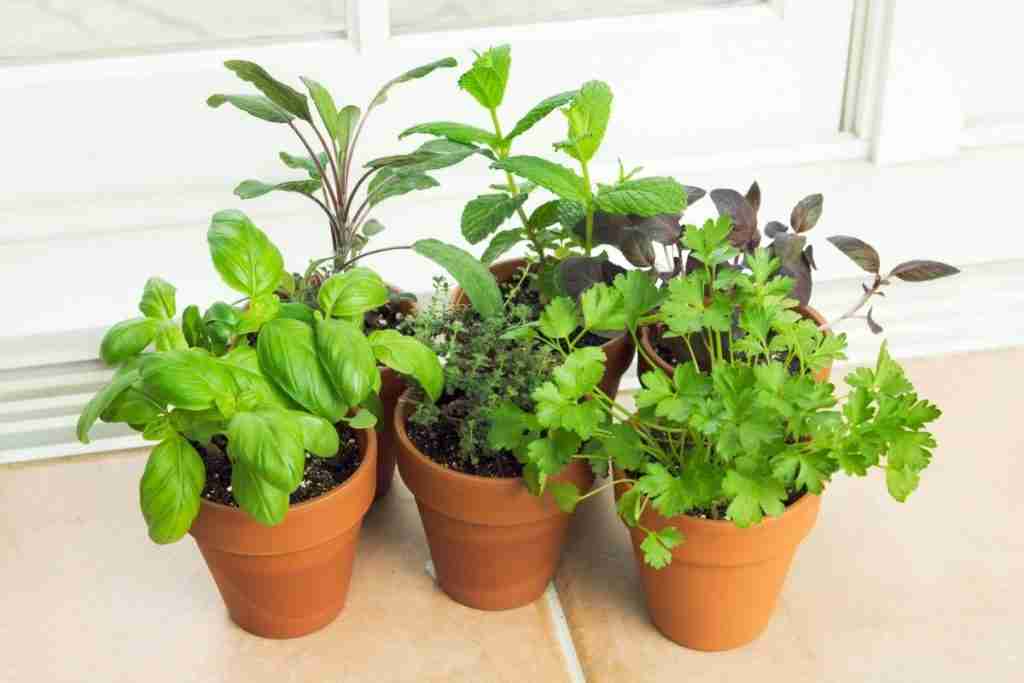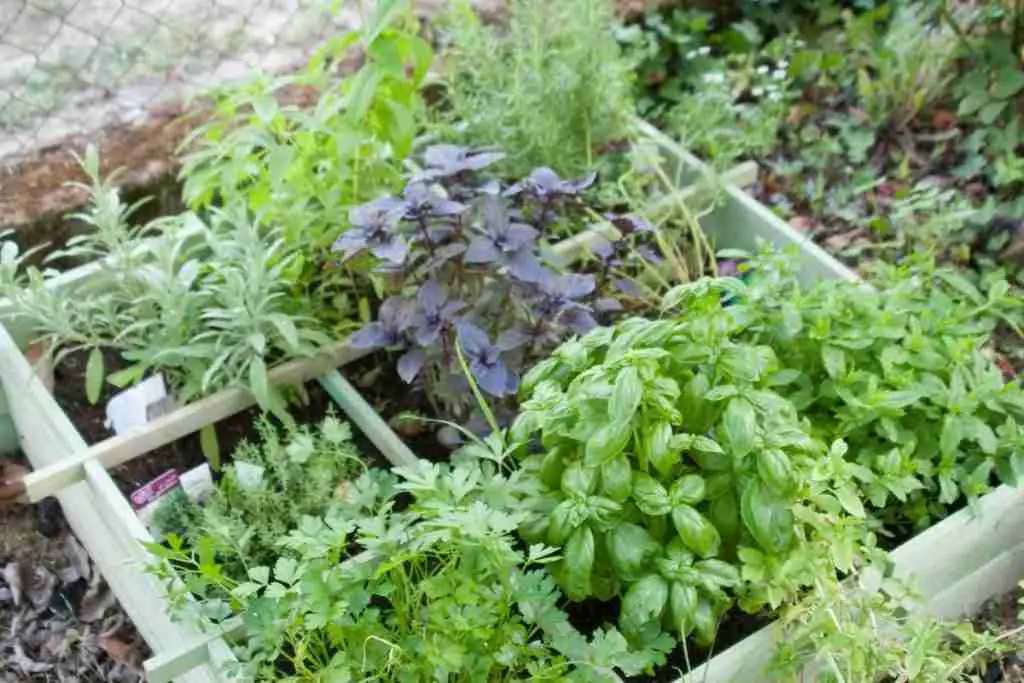
Herbs are some of the easiest plants to grow indoors. They can thrive all year round in the right conditions. Some herbs are much easier than others and can save you a lot of time and effort if you pick those options.
Below is a list of the best herbs for indoor gardens that are fairly simple to maintain and will provide plenty of benefits once they are ready to go.
Table of Contents
The 10 Easiest Herbs to Grow Indoors All Year Round

1. Basil
When growing herbs indoors, basil is one of the best fresh herbs for your indoor herb garden or your kitchen. Part of the Lamiaceae family, it is typically found in tropical regions from Central Africa to Southeast Asia.
Essentials for Growing Basil Indoors:
- Basil likes moisture
- Pruning is required after six to eight branches grow
- Basil thrives in warm climates
Health Benefits of Basil:
- Reduces inflammation
- Boosts mental health
- Fights infection
2. Chives
Chives are part of the Amaryllidaceae family and are a flowering plant that is a close relative to onions, leeks, and scallions. These perennial herbs are typically found in North America, Europe, and Asia.
Essentials for Growing Chives Indoors:
- Prefer full sun exposure but can survive with some shade
- Drought-tolerant and only require water once a week
- Thrive best in soil that is rich, well-draining, and moist
Health Benefits of Chives:
- Boost immunity
- Detoxify the body
- Enhance mood and sleep
3. Cilantro
Cilantro is an herb that comes from the leaves of the coriander plant. It is part of the parsley family and has been around for thousands of years. This culinary herb is even believed to have been used by Romans to flavor their bread way back in 5,000 B.C.
Essentials for Growing Cilantro Indoors:
- Harvest cilantro regularly to make room for new growth
- Cilantro requires full-sun access for adequate growth
- Grows best with frequent fertilization, such as compost
Health Benefits of Cilantro:
- Reduces stress
- Helps to detoxify the body
- Has antifungal properties
4. Mint

Mint is from the Lamiaceae family and has a spearmint-like scent. These plants are native to North America, Africa, and Australia and are known to be toxic to animals if ingested.
Essentials for Growing Mint Indoors:
- Does best in partial shade but will tolerate full sun if watered frequently
- Can thrive in almost any soil but prefers a rich, slightly acidic soil
- Best if potted alone; it can be an invasive herb
Health Benefits of Mint:
- Ease stomach aches and nausea
- Anesthetic properties
- Treats the common cold
5. Parsley
Parsley is a flowering plant in the Apiaceae family and is a native flower to Northern Africa and the Mediterranean region. Parsley was so popular in ancient Greece that they even wrote a poem about it.
Where is my beautiful parsley?”
Essentials for Growing Parsley Indoors:
- Sow seeds in the garden a 1/2 inch deep and six inches apart
- Harvest parsley using the cut-and-come-again method
- Plant parsley in full, direct sun
Health Benefits of Parsley:
- Full of essential nutrients
- Supports bone health
- Contains cancer-fighting substances
6. Sage
Sage is a greenish-grey plant that is part of the Labiates family and is native to Southern Europe and the Mediterranean area. This herb has a strong aroma that is delectable and natural.
Essentials for Growing Sage Indoors:
- Requires well-draining soil
- Requires full-sun exposure
- Doesn’t grow well when watered too much so keep the hydration minimal
Health Benefits of Sage:
- May lower “bad” LDL cholesterol
- Loaded with antioxidants
- Full of antioxidant properties
7. Dill
Dill is a relative of celery and is part of the Apiaceae family. Dill is grown widely in Eurasia and now in many places indoors around the world. This plant is also well-known for attracting pollinators.
Essentials for Growing Dill Indoors:
- Keep temperatures around 60°F-80°F
- Only provide water if the first top inch of soil feels dry
- Doesn’t require much nutrient-rich fertilizer
Health Benefits of Dill:
- Helps boost digestion
- Known to relieve menstrual cramps and pains
- Provides relief from respiratory illnesses
8. Catnip
Catnip is an herb that is typically associated with keeping the feline species in a playful and active mood. It is part of the mint family and is naturally grown in southern and eastern Europe, the Middle East, and Central Asia. While you can’t use catnip in any of your culinary dishes, it is still a beneficial herb to own.
Essentials for Growing Catnip Indoors:
- Doesn’t require tons of sun, will be happy with about five hours of it
- Limit blooming and cut back your catnip frequently
- Plant catnip in a container that’s about eight inches wide and eight inches deep
Health Benefits of Catnip:
- Can act as a natural sleep aid
- Known for repelling insects, including pesky mosquitoes
- Helps reduce digestive issues
9. Thyme
Thyme is considered a low-growing aromatic plant belonging to the Lamiaceae family, making it a relative of oregano and mint. This plant is indigenous to the Mediterranean and has been known for its culinary and medicinal benefits for hundreds of years.
Essentials for Growing Thyme Indoors:
- Keep thyme in hot, arid climates with temps around 60°F to 80°F
- Be especially careful not to overwater as that is a common cause of plant failure
- Requires around eight hours of full sunlight each day
Health Benefits of Thyme:
- Reduces high blood pressure
- Fights foodborne bacterial infections
- Aid in relieving and ridding yeast infections

10. Oregano
Oregano is one of the most popular herbs grown in indoor home gardens. This plant has small leaves and pink or purple flowers. The herb is part of the Lamiaceae family and is widely known for its use in Mexican dishes.
Essentials for Growing Oregano Indoors:
- A six-inch pot is an ideal size for this herb (ensuring there are plenty of drainage holes)
- Place in a south-facing window with six to eight hours of sunlight
- Best temperature is 65 to 70°F
Health Benefits of Oregano:
- Believed to help fight bacteria
- May help reduce viral Infection
- Has anti-inflammatory properties
Summing Things Up
There are many benefits that come with growing an herb garden indoors. Luckily, most herbs tend to do very well inside and can grow all year long if taken care of properly and given a little TLC each and every day.
